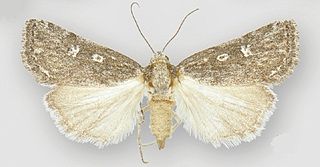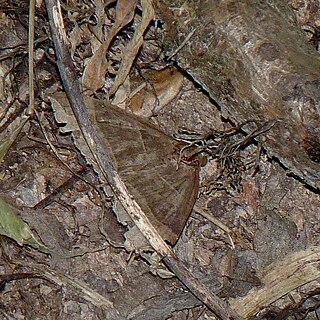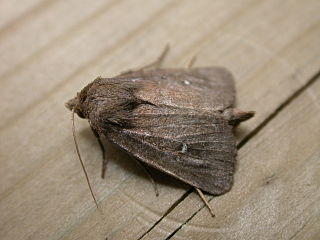
The willow beauty is a moth of the family Geometridae. It is a common species of Europe and adjacent regions. While it is found widely throughout Scandinavian countries, which have a maritime climate, it is absent from parts of the former USSR which are at the same latitude but have a more continental climate.

Xestia is a genus of noctuid moths. They are the type genus of the tribe Xestiini in subfamily Noctuinae, though some authors merge this tribe with the Noctuini. Species in this genus are commonly known as "clays", "darts" or "rustics", but such names are commonplace among Noctuidae. Xestia moths have a wide distribution, though they most prominently occur in the Holarctic.

Melitaea is a genus of brush-footed butterflies. They are here placed in the tribe Melitaeini of subfamily Nymphalinae; some authors elevate this tribe to subfamily rank.

Lomographa bimaculata, the white-pinion spotted, is a species of geometer moth. It belongs to the large geometer moth subfamily Ennominae, and therein to the tribe Baptini. It is – under its junior synonym – the type species of its genus Lomographa. It is also the type species of Bapta, a junior objective synonym of Lomographa and the namesake of the Baptini. The species was first described by Johan Christian Fabricius ion 1775.

Monopis obviella is a species of tineoid moth. It belongs to the fungus moth family (Tineidae), and therein to the nominate subfamily Tineinae. It is the type species of Blabophanes, today treated as a junior synonym of the genus Monopis. M. crocicapitella was only separated from the present species in 1859, and is still frequently confused with it even by rather recent sources.
Acontarache is a monotypic moth genus of the family Noctuidae. Its only species, Acontarache somaliensis, is found in Somalia. Both the genus and species were first described by Emilio Berio in 1977.
Agriopodes is a doubtfully valid genus of noctuid moths of the family (biology) Acronictinae. The genus was erected by George Hampson in 1908.
Araeopterella is a monotypic moth genus of the family Noctuidae. Its only species, Araeopterella miscidisce, is found in Panama. Both the genus and species were first described by Harrison Gray Dyar Jr. in 1914.

Auchmis is a genus of moths of the family Noctuidae.
Conicophoria is a monotypic moth genus of the family Noctuidae. Its only species, Conicophoria formosana, is found in Taiwan. Both the genus and species were first described by Shōnen Matsumura in 1929.
Escandia is a monotypic moth genus of the family Noctuidae. Its only species, Escandia fimbrialis, is found in Panama. Both the genus and species were first described by Harrison Gray Dyar Jr. in 1914.

Fotella is a monotypic moth genus of the family Noctuidae. Its only species, Fotella notalis, is found in the US in the Big Bend region of western Texas, southern Arizona, southern California and southern Nevada. The habitat consists of dry deserts. Both the genus and species were first described by Augustus Radcliffe Grote in 1882.
Oxygonitis is a monotypic moth genus of the family Noctuidae. Its single species, Oxygonitis sericeata, is found in the Indian subregion, Myanmar, Sumatra, Peninsular Malaysia, Java, Borneo, the Philippines, Sulawesi, Australia and Sri Lanka. Both the genus and species were first described by George Hampson in 1893.

Parallelia is a genus of moths in the family Erebidae. The genus was erected by Jacob Hübner in 1818.

Psimada is a monotypic moth genus of the family Noctuidae. Its only species, Psimada quadripennis, is found in the Indian subregion, southern China, Taiwan, Myanmar, Thailand, Sri Lanka, the Andaman Islands, Sundaland, Sulawesi and Seram. Both the genus and species were first described by Francis Walker in 1858.
Rhiza is a genus of moths of the family Noctuidae. The genus was described by Staudinger in 1889.

Orthonama is a genus of the geometer moth family (Geometridae). It belongs to the tribe Xanthorhoini of the "carpet" subfamily (Larentiinae). Nycterosea is usually included here by modern authors, but may in fact be distinct enough to warrant recognition as an independent genus. The genus was erected by Jacob Hübner in 1825.

Lenisa is a monotypic moth genus of the family Noctuidae erected by Michael Fibiger, Alberto Zilli and László Aladár Ronkay in 2005. Its only species, Lenisa geminipuncta, was first described by Adrian Hardy Haworth in 1809. It is found in southern and central Europe, Lebanon, Israel, Turkey, Iraq and in the Caucasus. Some authors place this genus name as a synonym Archanara, and the species as Archanara geminipuncta.

Goniographa is a genus of noctuid moths. They belong to the tribe Xestiini of the typical noctuid subfamily Noctuinae, though some do not separate this tribe and include the genus in the Noctuini.
Xestia hypographa is a moth of the family Noctuidae. It is only known from the north-western part of the Tien-Shan Mountains.












